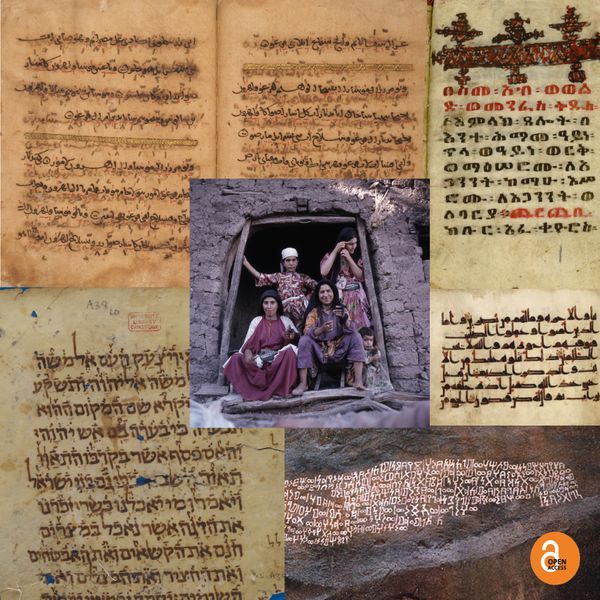A Charred Cathedral in Paris and A Modern Masterpiece in Glass: Le Jongleur de Notre Dame
by Jan M. Ziolkowski
On April 15, 2019, dismayed millions around the planet stared at phones, televisions, and computers as smoke billowed and flames engulfed Notre Dame de Paris.

For anyone who holds Gothic art and architecture dear, merely recollecting the image is painful. But the hurt affected far more than just lovers of the Middle Ages and its multiple cultures: for everyone who cares about cultural heritage and civilization, the blaze risked harming the very essence of France itself. Since the late nineteenth century, the Gallic heart has had two ventricles, with the Eiffel Tower embodying the country’s cutting-edge modernity and the cathedral exemplifying its ancestral cultural heritage.
Like many Gothic churches, the gem of medieval stonework in the French capital weds distinctive architecture with equally characteristic art. Among other things, it exists courtesy of structures such as pointed arches and flying buttresses that permits its weight-bearing walls to be penetrated by windows. In turn, the apertures are filled with pane after pane of colored glass. Consolingly, its three famed roses and other lesser lights weathered the firestorm.
Many present lives play out in postmodern cities where spikes of steel sheathed in glass fence in human inhabitants.

Today such transparency surrounds us, whether looking out of openings or in through them, though we seldom stop to contemplate the meanings and mysteries of our vitreous environs, let alone to ponder what is bygone. But churches and their closest relatives can serve as time machines. The stained glass of medieval and medievalesque edifices transports us back to imagined pasts. The windows have qualities all their own, in blues and reds, shapes and thicknesses, and figurative scenes from forgotten stories, that force us to stop and think: glassy-eyed takes on new implications.
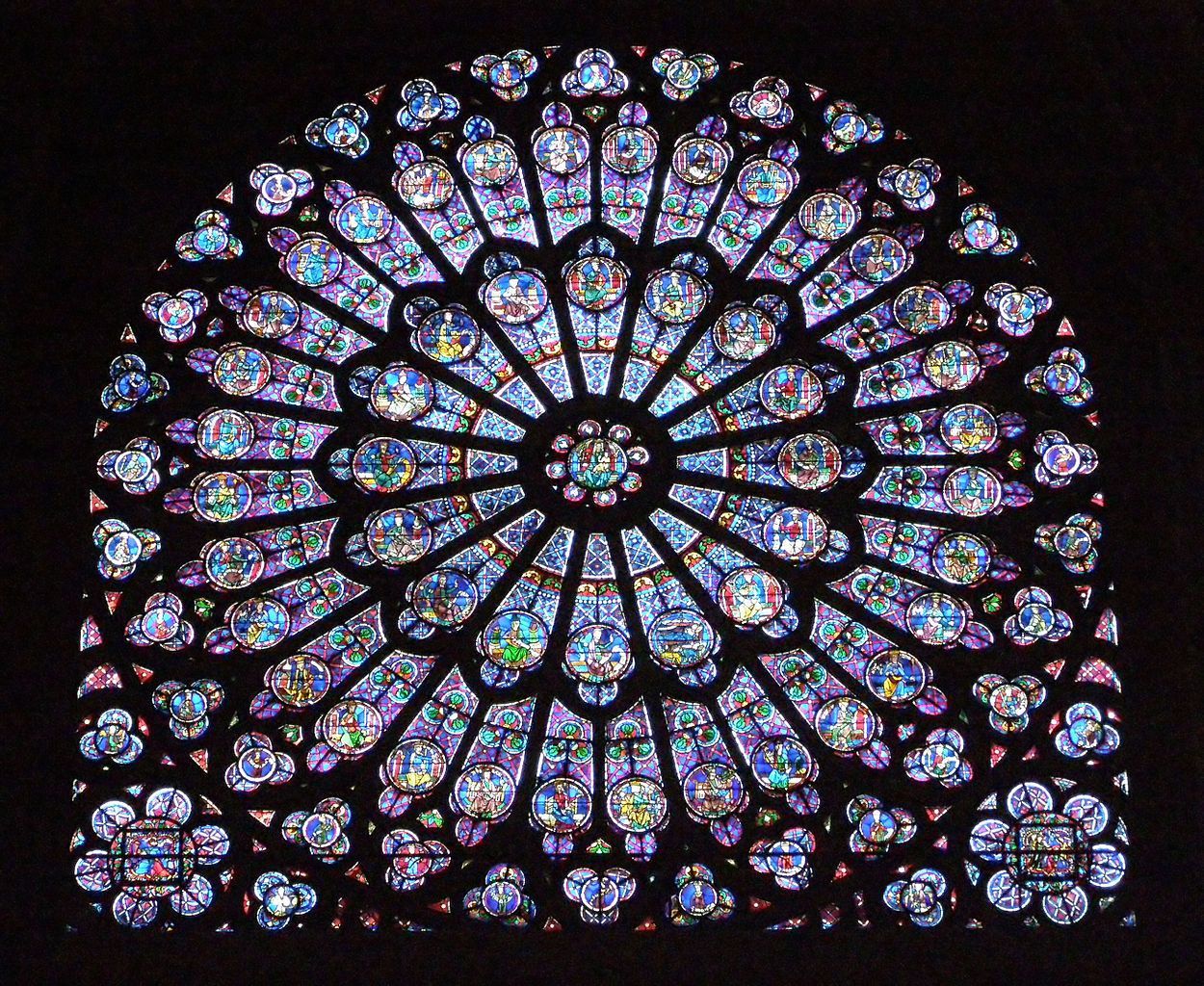
This blog post takes its title from the first letter of Paul to the Corinthians. To quote from the King James Bible:
For now we see through a glass, darkly; but then face to face: now I know in part; but then shall I know even as also I am known. And now abideth faith, hope, charity, these three; but the greatest of these is charity (1 Corinthians 13: 12-13).
In the first of these two verses, seeing “through a glass” means peering into a reflecting surface.
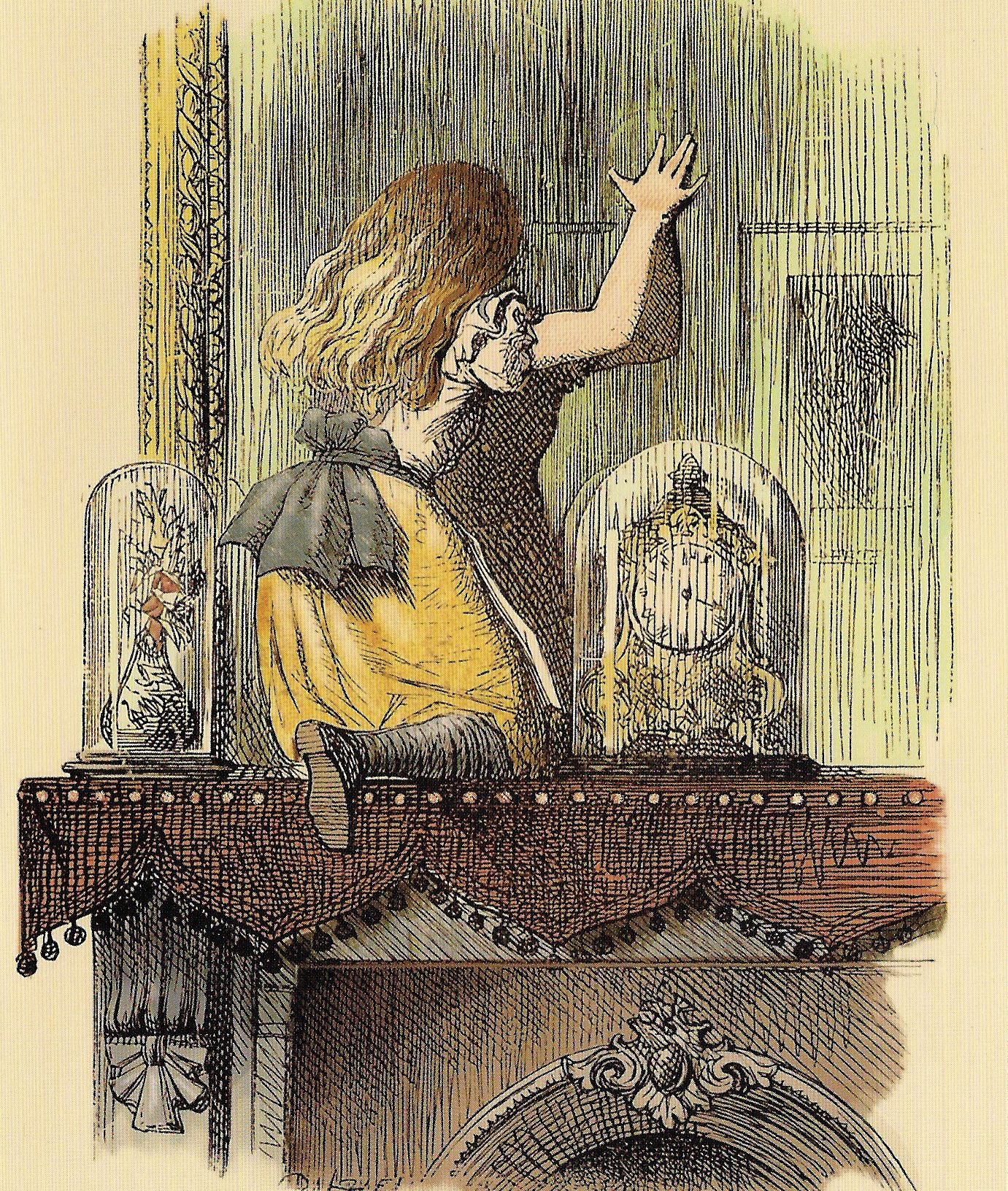
The vision takes place “darkly” because here and now the substance allows only an obscure and imperfect perspective on reality, whereas at the end of time it will grant a clear sight.
The Apostle could not have had stained glass in mind. When he wrote, its use in houses of prayer lay more than a thousand years ahead. Furthermore, panes of the medieval medium have little in common with mirrors. Those who view panes from the Middle Ages are meant not to seek out their own reflections but to attain enlightenment by apprehending people and actions that help in decoding the correspondences between God’s macrocosm and man’s microcosm.
The stained glass in Gothic churches lent itself especially well to representation of foundational beliefs held by worshipers who performed devotions there. Medieval artisans often depict the theologically foundational moment of the annunciation with the Holy Ghost as a beam of light that emits from heaven through a window and often through a pane into the Virgin.
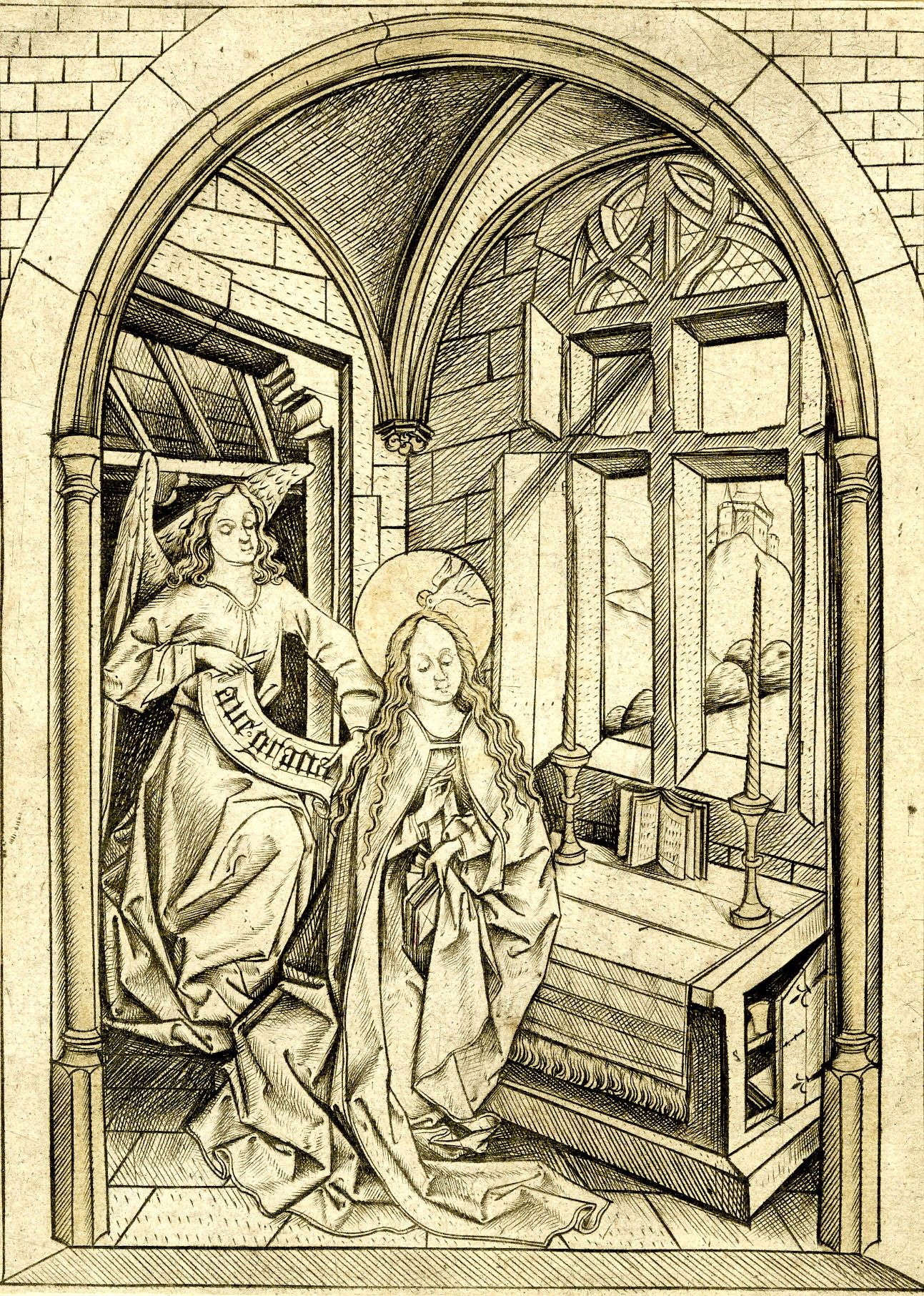
The underlying conception holds that as light penetrates glass without touching it, so the Holy Spirit renders Mary with child while leaving her virginity intact. The glass is equated to a hymen. Whatever stand we take on this doctrine, stained glass confronts us with the reality of a medium that, like cinematic film, requires the passage of photons through it to become animate.
A Translucent Triumph: Le Jongleur de Notre Dame
A year ago fire enveloped one nation’s cultural monument. The current conflagration of the COVID-19 pandemic threatens an entire species. Much of the developed world has been driven into high-tech hiding. Global jetsetters of a few months ago have morphed into computer cavemen, fearful of the novel coronavirus that invisibly infects the environment and fellow human beings alike. People huddle in homes, waiting for the disease’s undetectable droplets to dissipate. Though the situation could encourage despondency, we would do better to focus on creation and not contagion, on hope and not horror. What new Decameron will we tell to entertain and edify one another? What scenes will we daub on walls around us?
And so we arrive at the second topic of these paragraphs, a single beautiful work of stained glass that was crafted in 2018. The maker was the Atelier Miller in Chartrettes, a commune about fifty miles southeast of Paris.
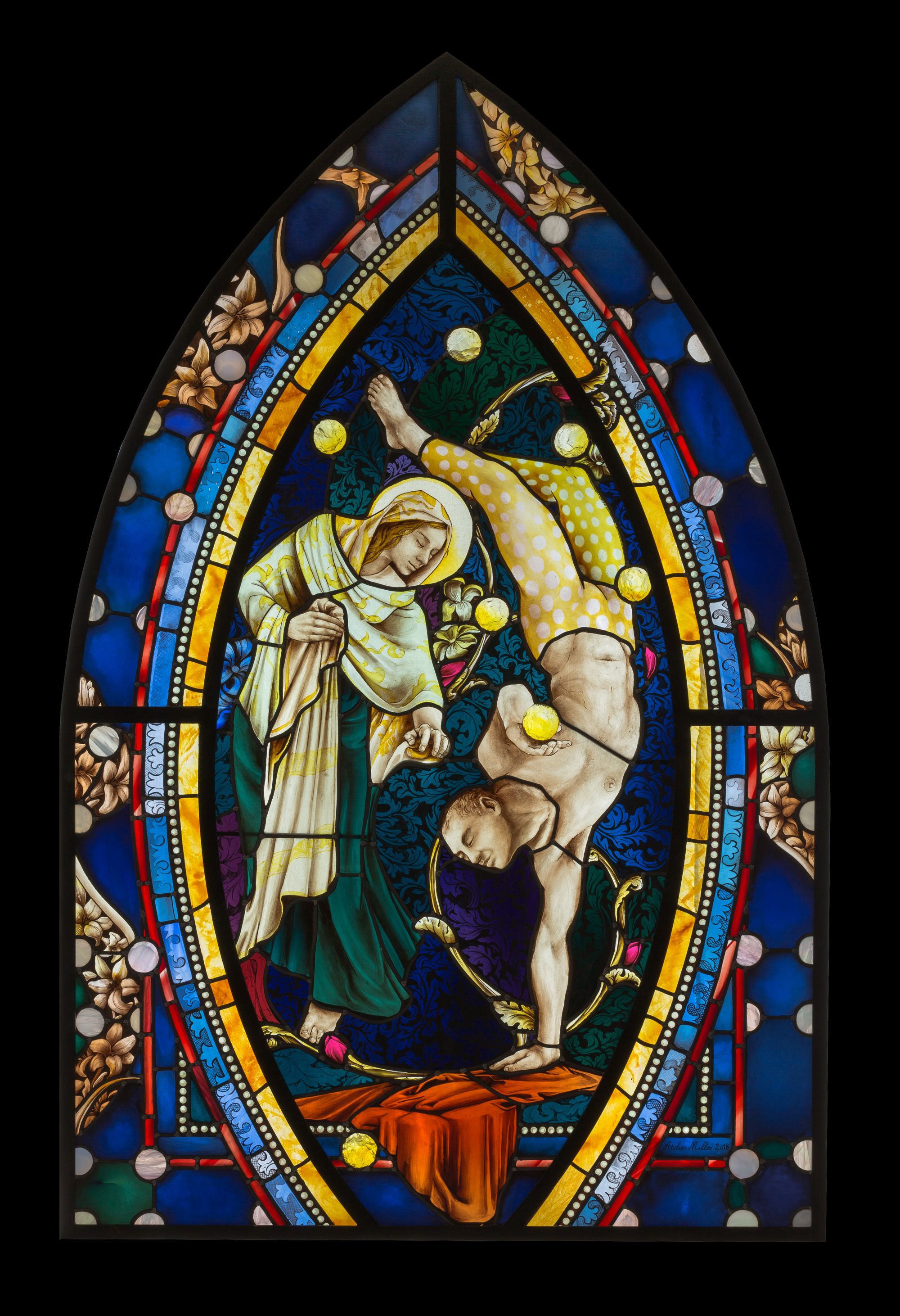
The artwork now resides across the Atlantic in Dumbarton Oaks, where it has featured on covers of an exhibition catalogue and of an annual report. The glass depicts the culmination of a story called Le Jongleur de Notre Dame. In this episode, a juggler presents the Virgin the only offering he can, by juggling before a Madonna. In a miracle, Mary materializes to soothe him when he collapses after his performance. The narrative was put into French poetry early in the thirteenth century, distilled into Latin prose a few decades later, and forgotten from the early modern period until the late nineteenth century. After its rediscovery a remarkable French scholar named Gaston Paris helped to popularize it, the Nobel Prize-winner Anatole France transformed it into a beloved classic of short fiction, and the celebrated composer Jules Massenet brought it onto the opera stage. Though its heyday was the Gilded Age, it remained vibrantly living throughout the twentieth century in many retellings. Nowadays it thrives in children’s books, as the recent death of Tomie dePaola reminded us.
My six-volume exploration The Juggler of Notre Dame tracks the story from its beginnings down into the twenty-first century, while simultaneously investigating our ever-changing attraction to the Middle Ages. Though my study trawls deep and broad, the stained glass from 2018 eluded my catch for the simple reason that it was made too late. The incompleteness deserves celebration: a theme truly lives on when it continues to be reconceived and recreated, and nothing will benefit the tale more than if artists of all sorts persist in engaging with it.
The glasswork was produced specifically for the exhibit “Juggling the Middle Ages” that ran from October 15, 2018 through March 3, 2019. Why? The museum installation afforded an opportunity to correct an omission through a commission. Extra effort was required to insure that the show, based on literature, would not overfocus on the two-dimensionality of print culture. The medieval story had infiltrated many media: short story, novel, opera, dance, radio, television, cartoon, film, painting, sculpture, and more. The medievalizing artists of the twentieth century who illustrated Le Jongleur de Notre Dame in books often drew inspiration from stained glass, and in fact they even made the form a backdrop in their expressions of the story. But the juggler, however beloved, had never been memorialized in stained glass. The closest approach had been a lamp, a work in the round by a Franco-American sculptor, Armand.
By background I was predisposed, even if largely unconsciously, to glass. I had been exposed to it first in Marc Chagall’s “Peace Window,” both at the United Nations in New York and on postage stamps.
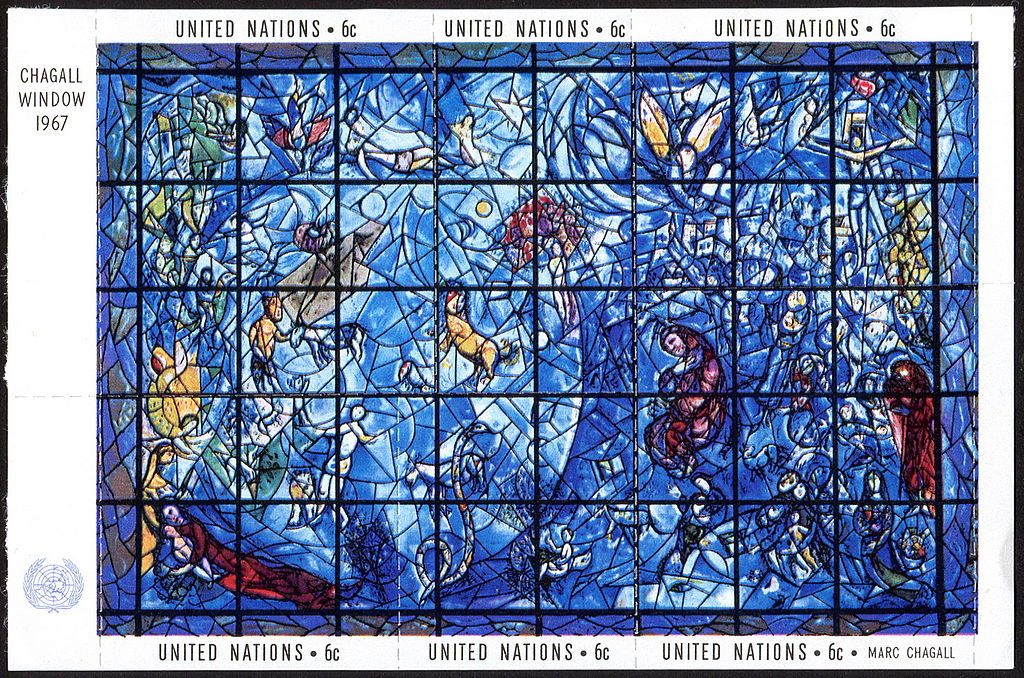
The tour de force was dedicated in 1964 as a memorial to the late Dag Hammarskjøld, second Secretary-General of the United Nations. The glass teems with biblical imagery, such as elements of paradise and motifs of peace, a central tree with a snake at its roots, the ten commandments, and a couple with a child. Alongside the Bible is symbolism of music and dance, relating to Beethoven’s Ninth. The ensemble is at once seething and soothing. The apparent paradox between those two attributes makes good sense, since it relates to the very nature of stained glass.
The material befits an organization devoted to peace, and not just because the substance is found so often within churches. My own attraction to the stuff owes partly to its intermediate nature. A common misapprehension holds it to be not a solid but a supercooled liquid. In antique windows the panes are often thick-bottomed, and the explanation goes that they slowly ooze downward. On the contrary, glass is an amorphous solid that exists in a strange state between liquid and its opposite. That intermediate condition offers a middle way. In today’s partisan world people are expected to be either/or. Glass is the slash.
In the late 1960s and 1970s, my casual exposure to the genre expanded. During those years Tiffany & Co.-style glass lamps became chic in American popular culture. Originals were few and far between, but replicas abounded. The oeuvre of John La Farge was not so well known, since it had not been factory-produced. Then there was the stained glass of Europe, considered by many the only real thing, which mass tourism brought to the attention of ever more travelers.
A couple of decades into the twenty-first century, I had the idea of adding glass to the exhibit. But who could fabricate it? Eventually I realized eventually that the person with the right combination of an artist’s creativity and a businessman’s can-do-ism was an old but intermittent friend, Jeffrey Miller. In 1985 he had started a stained glass studio in Paris, which led eventually to the establishment of Atelier Miller. The glass resulted from his collaboration with his daughter, the Paris-based artist Sarah Navasse, and the master craftsman Jeremy Bourdois. In a future piece I will interview Jeff about the creative thought behind the design and the practical demands of the making.


